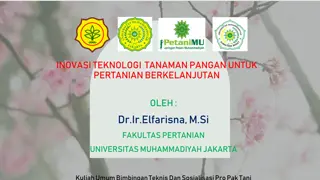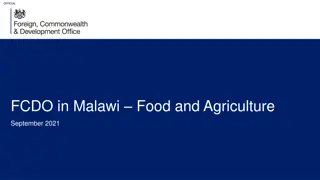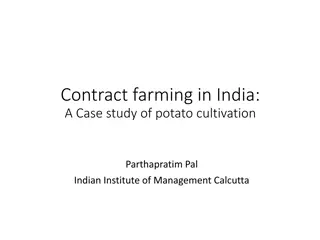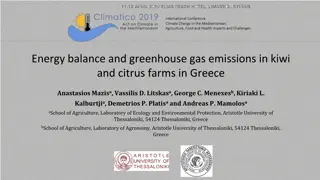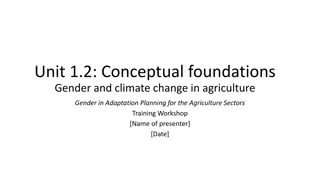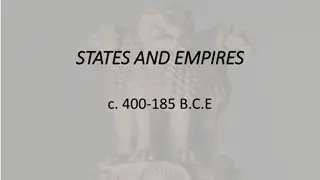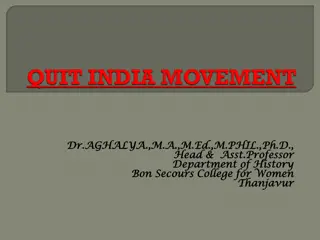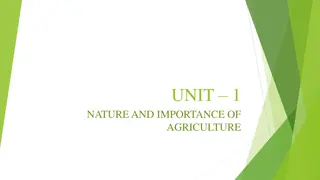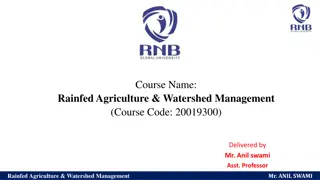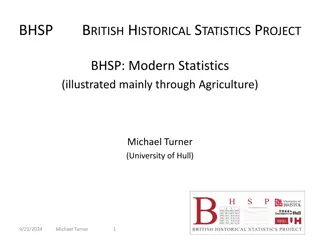
Insights into Ancient Indian Agriculture Systems
Ancient Indian agriculture systems date back to the pre-Harappan period, showcasing innovations like ploughing, irrigation, and crop cultivation. The Indus Valley Civilization relied on rainfall harvesting and had sophisticated irrigation systems. During the Mauryan Empire, soil categorization, meteorological observations, and agricultural advancements were made. Agriculture has played a vital role in India's economy since ancient times, contributing to productivity, stability, and national prosperity.
Download Presentation

Please find below an Image/Link to download the presentation.
The content on the website is provided AS IS for your information and personal use only. It may not be sold, licensed, or shared on other websites without obtaining consent from the author. If you encounter any issues during the download, it is possible that the publisher has removed the file from their server.
You are allowed to download the files provided on this website for personal or commercial use, subject to the condition that they are used lawfully. All files are the property of their respective owners.
The content on the website is provided AS IS for your information and personal use only. It may not be sold, licensed, or shared on other websites without obtaining consent from the author.
E N D
Presentation Transcript
AGRICULTURE SYSTEM IN ANCIENT INDIA The chief occupation of the people was agriculture. They ploughed the ground, the plough being drawn by two oxen fastened to the yoke with hempen or leather traces and driven with a goad. The ploughshare was made of iron, which supplanted the older ploughshare made of khadira wood.
INTRODUCTION Agriculture plays a vital role in India s economy. The Indian agriculture system began as early as 9000 BC. During this period, techniques were developed for the settled mode of production in agriculture and wheat, barley and jujube were the popular crops that were domesticated in the subcontinent by 9000 BC. The farm sector is contributing greatly to the productivity and stability of the country's economy due to which it has been believed that agricultural prosperity is fundamental to national prosperity. At present It accounts for about 18% of India s gross domestic product, provides employment to 58 per cent of her working population and the rural households depend on agriculture as their principal means of livelihood. Agriculture, along with fisheries and forestry, is one of the largest contributors to the Gross Domestic Product (GDP). New techniques were developed in the Neolithic period to improve the method of agriculture system like threshing, planting crops in rows, cotton spinning and storing grains in granaries. And they passed their improved techniques of agricultural production to the next generation. This transformation of knowledge was the base of further development of agriculture in India. The recognition of the origins and the historic, non environmental limitations on distribution of useful plants which arises from such study has many practical applications today. Hence, it is pertinent to study the system of Indian agriculture in ancient times.
ANCIENT INDIAN AGRICULTURE, IN PRE HARAPPAN PERIOD 1.1.Ancient Indian Agriculture System in Indus Valley Civilization Indus Valley civilization relied on achievements of the pre-Harappan culture, including the plough. The farmers of the Indus Valley grew peas, sesame and dates. Rice was also cultivated in the Indus Valley Civilization. The method of agriculture which Indus civilization people practiced was rainfall harvesting. Due to discovery it came into the light that Indus civilization people had a series of massive reservoirs to meet the city s needs during the dry season. The main basis for the Indus valley economy was mixed farming. Irrigation was developed in the Indus Valley Civilization by around 4500BC. As a result of this innovation in irrigation, the size and prosperity of the Indus civilization was grown. Sophisticated irrigation and water storage systems were developed by the Indus Valley Civilization, including artificial reservoirs at Girnar dated to 3000 BC and an early canal irrigation system in 2600 BC. the considerable technology
1.3.Ancient Indian Agriculture in Mauryan Empire 1.3.Ancient Indian Agriculture in Mauryan Empire The Mouryan Empire (322-185BCE) categorized soils and made meteorological observations for the agricultural use. Other Mauryan facilitation included maintenance of dams and provision of horse-drawn chariots which was quicker than traditional bullock carts. The Greek diplomat Megasthenes (300BC) in his book Indika provides an eyewitness account of Indian agriculture at that time. He writes, India has many huge mountains which abound in fruit-trees of every kind, and many vast plains of great fertility. The greater part of the soil is under irrigation and consequently bears two crops in the course of the year. In addition to cereals, there grows millets and different sorts of pulse and rice throughout India. Since there are two monsoons in the course of each year the inhabitants gather in two harvests annually. construction and
ANCIENT SOUTH INDIAN AGRICULTURE 1.4.Ancient South Indian Agriculture The agriculture scene of South India was equally bright in Ancient India. The south people cultivated a wide range of crops such as rice, sugarcane, millets, black pepper, various grains, coconuts, beans, cotton, tamarind and sandalwood, jackfruit, coconut, palm, areca and plantain trees etc. systematic ploughing, manuring, weeding, irrigation and crop protection was practiced for sustained agriculture in South India. Water storage systems were designed during this period. Kallanai (1st -2 nd century AD), a dam built on river Kaveri is considered the as one of the oldest water-regulation structures in the world that is still in use.
1.5.Ancient Indian Agriculture in Chola Period 1.5.Ancient Indian Agriculture in Chola Period The agrarian society in South India during the Chola Empire (875-1279) reveals that collective holding of land slowly gave way to individual plots, each with their own irrigation system during Chola rule. The Cholas also had bureaucrats which oversaw the distribution of water, particularly the distribution of water by tank-and-channel networks to the drier areas. The growth of individual disposition of farming may have led to a decrease in areas of dry cultivation.5 The Indian economy in the pre-British period consisted of isolated and self-sustaining villages on the one hand, and towns, which were the seats of administration, pilgrimage, commerce and handicrafts, on the other. Means of transport and communication were highly underdeveloped and so the size of the market was very small. To understand the agriculture system in pre-British India, it is essential to study the structure and character of the village community, the character of internal and foreign trade, the state of the means of transport and communications.
ROLE OF AGRICULURE IN INDIAN ECONOMY Agriculture has always played a dominant role in the Indian economy from the very beginning. It also provides employment to about seventy percent of the working population in the country, besides ensuring raw materials for most of our industries. Apart from these material considerations, agriculture offers a way of life based on human values of cooperation and labour. Agriculture invariably, has been a bedrock for a rich and living culture and civilization of India. The well- being and progress of the nation is closely connected with agriculture. So agriculture and farming profession deserve to be respected for the prosperity of the country
Agriculture Development in Ancient and Medieval India Agriculture has always played a dominant role in the Indian economy from the very beginning. It also provides employment to about seventy percent of the working population in the country, besides ensuring raw materials for most of our industries. Apart from these material considerations, agriculture offers a way of life based on human values of cooperation and labour. Agriculture invariably, has been a bedrock for a rich and living culture and civilization of India. The well-being and progress of the nation is closely connected with agriculture. So agriculture and farming profession deserve to be respected for the prosperity of the country. The archaeological excavations at Harappa, Mohenjodaro, Rakhigarhi and Lothal tell us that the Indus Valley Civilization has witnessed among others the use of plough and the wheeled cart in raising the production of wheat, barley, rice, maize, millets, cotton, etc. Horticulture was concentracted around the urban centres with a preponderance of people, not directly engaged in agriculture. The Harappan culture (3500 B.C. 1500 B.C.) is, rightly called the age of irrigated farming
MAJOR CROPS GROWN IN ANCIENT INDIA is also quite clear excavations that the agriculture and animal husbandry went together. Even the pre-Harappan levels of Kalibangan in western Rajasthan, had domesticated cattle. India was also regarded as the home of Mung and mash. In the vedic and post-Vedic period mash enriched the Indian diet, cookery and religious ceremonies to great extent.2 It is thought that rice, which is the most extensively cultivated crop in the world and which serves as the staple food for the largest population these days, had its cultivation originated in India, Burma or Indo-China. It from the archaeological
AGRICULTURE IN VEDIC LITERATURE Furthermore, the Vedic literature indicates that the cultivators in the Vedic period possessed a fair knowledge of the fertility of land, selection and treatment of seeds, seasons of sowing and harvesting, rotation and other cultural manuring for increase of production of crops and the like. Jaittiriva Samhita mentions that rice would be sown in summer and pulses in winter on the same field practices of crops,
AGRICULTURE IN BUDDIST PERIOD During the Buddhist period people retained their interest in agriculture. The usefulness of cattle was also fully realised by the people. The evolution of gardening is intimately associated with Buddhist temples and monasteries. The Mauryan period also, laid great stress on the promotion agriculture, forest produces, pasture lands, cows, horses and elephants
The animal husbandry made a tremendous progress and the veterinary service was made available to the community. Magasthenes, the Greek ambassador at the court Chandragupta Maurya (321 BC 297 BC) records that Famine has never visited India and there has never been a general scarcity in the supply of nourishing food
AGRICULTURE : A MAJOR SOURCE OF INCOME The Arthashastra, the chief source of all sorts of knowledge of this period, mentions the name of various crops like Sali (rice), varichi (rice), tila (sesamum), yoda(barley), godhuma (wheat), atasi (linseed) and sarshapa (mustard). The mash pulse began to be used as a horse food during the Mauryan and Kushan period masha, masura,
AGRICLTURE DURING KING ASHOK PERIOD Ashoka (273 B.C. 232 arboriculture and horticulture. Sanchi provides us with a glimpse of this culture. Veterinary hospitals were state institutions and were functioning all over the empire during the Ashoka period. After the Mauryans, the Sungas ruled India. In this period 2 brick-wells and improved agricultural implements of iron were found in abundance. Cultivation of rice and coconut palms was done extensively B.C.) actively promoted
The people of Deccan, the Satvahans (Andhras) cultivated cotton and Andhra was known for its cotton cloth, because of extensive cultivation of cotton there. According to R.S. Sharma, the art of transplanting rice seedlings was widely practiced in the first two centuries in the deltas of Krishna and Godavari, which became the rice bowl of south India . Iron technology made great progress in the age of Satvahans (235 BC 25 A.D.) and Kushan (78 A.D. 200AD
The south Indian culture, which broadly fall into two groups, viz. the Tamil group, comprising Pandyas (560-920), Cheras, Cholas (850-1311), Hoysala (1022-1342), Kakatiyas Pallavas (550-912) and the Deccan group comprising Chalukyas (535-1200) and Rashtrakutas (735-993) is endowed with a powerful originality. Though these states were engaged in fighting among themselves and nibblings at each others territories, yet their contribution to agriculture and to the culture of India as a whole is of tremendous importance. (1100-1323) and
During the period of the Guptas (A.D. 300 - 550) the Hindu culture was at its peak. Besides renaissance in art, literature and science, agriculture also flourished greatly. But the land taxes were heavy, Dr. R.S. Sharma, states that in the Gupta period land taxes increased in number and these on trade and commerce decreased. Probably, the king collected taxes varying from one- fourth to one-sixth the produce. In addition to all this, whenever the royal army passed through the country-side, the local people had to feed it. The peasants had to supply animals, foodgrains, furniture etc. for the maintenance of royal officers on duty in the rural areas.
VEDIC PLANT PTRECTION METHODS Our sources of information about the life of the people and their agriculture and horticulture in the Gupta age are Vatsyayana s Kamasutra, Varahamihira s Brhatsamhita and Amarsimha s Amarakosa. Varahmihira was an astronomer, astrologer and encyclopaedist. He flourished in the period A.D. 505-587. His Brhatsamhita provides information on agriculture, botany and zoology, apart from astronomy, medicine, metallurgy and geography. It describes specific characteristics of animals and the treatment of plant diseases. The Brhatsamhita and the Puranas particularly the Agnipurana, incidentally deal with the selection of land, manuring, cultivation,, collection and the treatment of seeds, sowing, planting, Brhatsamhita meantions the names of some plants and the method of their propagatio reaping and grafting. The
PACKAGE OF PRACTICES IN AGRI. The ploughmen sang merrily to the steers while ploughing; they bedewed the furrow with ghi and honey before sowing. The fields were watered by means of irrigation canals, from wells or lakes, or by raising water from wells by means of wooden or metal buckets tied to a rope pulled round a stone pulley. They kept away birds from robbing them of the growing corn by uttering loud cries. They reaped the fields with sickles and stacked the sheaves near, leaving three sheaves, to the good goblins that guarded the field. Four sheaves were tied together and hung in the house to propitiate the goddess of the house. They threshed them on threshing-floors, winnowed the corn in winnowing baskets and then carted it to their homes and stored it in granaries. It was measured before being stored, the unit of measure being called khari.
METHOD OF CULLTIVATION Sacrifice to the gods is figuratively described as agriculture. Lay on the yokes, and fasten well the traces. Formed is the furrow; sow the seed within it. Through song we may find hearing fraught with plenty: near to the ripened grain approach the sickle; wise, through desire of bliss from gods, the skilful bind that traces fast, and lay the yokes on either side. Arrange the buckets in their place: securely fasten on the straps. We will pour forth the well that hath a copious stream, fair-flowing well that never fails.


